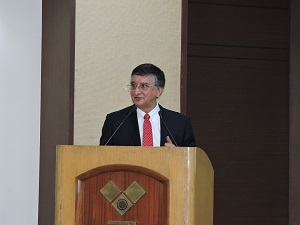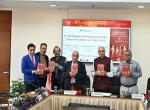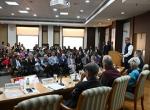Introduction
On 28th July, 2022 Vivekananda International Foundation organized a Vimarsh on “Food and Nutrition Security-Key to National Security, Staying in Course”. Opening and welcome remarks were made by Dr Arvind Gupta, Director VIF, during which he introduced the speaker and gave his brief point of view on the subject. In his introductory address, Dr Gupta welcomed Mr Bishow Parajuli, Representative of the United Nations World Food Programme and also the Country Director to India. Dr Gupta highlighted that in his capacity as a World Food Programme Representative, Mr Parajuli works on issues relating to food and nutrition security in the country. Dr Gupta also stressed on the fact that the speaker very well understands the link between food security and poverty.
After introducing the speaker, Dr Gupta delivered his brief point of view on the subject.
According to him, although poverty levels have reduced in South Asia, food security and nutrition remain areas of concern. There is a clear link between peace, prosperity, and food security. Mr Parajuli has written an article titled “Peace and Prosperity through Food Security” for the VIF quarterly journal National Security. As per the World Food Programme, even today, nearly 650 million people around the world are suffering from chronic hunger which is a situation worse than 2014. Additionally, nearly 250 million people needed urgent food assistance in 2021. In today’s geopolitics, food security has come to occupy a very high priority subject of discussion. The U.N. Food Summit in 2021 was a major event that focussed on global attention on food and agriculture. The disruption of grain exports from Russia and Ukraine has resulted in spike in food prices all over the world. Combined with high energy prices, the rise in food inflation has contributed to a surge in inflation across the world.
Before the green revolution, Indian population faced acute food scarcity. Fortunately, the situation has now reversed with India emerging as a food surplus country. Apart from raising its agriculture production, India has taken several steps to expand and strengthen its food safety net. Food security is a top priority for the government of India. It has supplied grains to many countries including Afghanistan in humanitarian assistance. However, India cannot always be complacent. Feeding 1.4 billion people every day for the rest of their lives is a daunting task particularly when global uncertainties are deepening and world systems are getting fragmented. Climate change is having a visibly adverse impact on agriculture production. As weather systems get disturbed, floods and droughts become more common, the need for re-inventing agriculture is a very relevant theme which has been mentioned in the speaker’s article. There is a need to build food stocks and also distribution system and building resilience. There is also a need to address the problem of malnutrition amongst children. This problem is particularly acute in Sub-Saharan Africa and South Asia. It is high time that the countries of the South Asian region come together to build food and nutrition security in the region and India can play some role in that.
World Food Programme has played a stellar role in fight against hunger. India has been collaborating closely with WFP on several projects.
Address by the Speaker
In the next one-hour talk, the speaker touched upon many important points which included challenges related to global food crisis, its causes, its implications and solutions. There is enough food in the world but the challenge is still that one in nine people are hungry on this planet. We are talking about 7.5 billion people for which the world produces enough food; however this population is only going to rise. This will lead to more struggle and fight to get that same amount of food or even less amount of food with the challenge of climate change and the others, if the world doesn’t prepare and act now. That’s really a question in terms of going forward because that can have consequences from multiple angles and which is in interest of countries and its security. 2022 has been an unprecedented year from a multiple point of view. Covid hit very hard, lots of challenges with business, lots of people losing jobs and opportunities, the consequences of which has been severe. The reference was made about 700 or so million people not getting enough food which has now gone to 828 million based on latest estimates. The Covid alone had doubled the people not getting enough food which is from 130 million to 270, and now that number has gone up to 345 million. The result is price rise, consequence of Ukraine war, and continued conflict as well as climate change. These are serious concerns for many countries. Many countries, because of the concern of food are taking loans to buy food as there is a problem of availability, there is a problem of higher prices, and more people are having to resort to reduced meal, limited content of food i.e., only calorie or small amount of protein or absence of protein, vitamin, and mineral. Adequate food is a food which is enough for us to have a healthy living with complete calorie, protein, vitamin, and minerals.
There are four reasons for increase in hunger such as conflict, climate shocks, economic consequences, and costs which are discussed in detail below:-
- Conflict- is one of the major reasons. 60 percent of the global hunger is attributed to conflict these days. Millions of people in several countries in Africa, Middle East, and now Ukraine are displaced. Around 8 million people are out of home in Ukraine are now dependent on health and aid from others.
- Climate Change-The rise in temperature causes changes in rainfall patterns, impacts ability for the crop to grow, and high intensity of rain or low intensity of rain or drought, cyclone, melting of snow, these all have consequences such as displacement, impact on livelihoods, impact on food, migration, and on health. Many non-communicable or communicable diseases can emerge from the concern of climate change.
- Economic Consequence-The pandemic which led to loss of job and opportunities had severe consequences for people.
- Costs-There is an overall rise in cost because of this situation. The World Food Programme (WFP) spends at the moment $73.6 million a month on feeding people because of higher price.
There are several countries emerging with hunger hotspots. Latin American countries which were normal middle-income countries facing consequences because of the price rise. The consequences of climate change will have an availability that is the supply side of it because in several countries the consecutive years of drought has led to farmers completely being left out with nothing. Changes in production, in turn, can affect the ability of households to access food and thus will have an impact on dietary diversity. In fact, changes in rainfall and temperature patterns directly impact livelihoods that depend on climate-sensitive activities such as rain-fed agriculture and livestock rearing.
The IPCC report titled “Climate Change 2021: The Physical Science Basis” makes a reference that 76 percent of the global population are affected by weather. Over 80 percent of the world’s food-insecure live in degraded environment. The general concern is mostly the vulnerable people. The poorer people get affected with these situations. India has a scheme called “Pradhan Mantri Garib Kalyan Yojana” which was initially announced in March 2020 to reach out to the poorest of the poor with food and money in hands so that they do not face difficulties in buying essential supplies and meeting essential needs, but many countries do not have it.[1] The consequence is that if there is no food, it results in increasing crime and multiple concerns such as food riots, protests and also political instability. Hence, it is important to have right policies and programs to be in place to contribute to stability and peace.
The Russia-Ukraine war couple with Covid, has really brought the world shaking in terms of supply situation, in terms of price situation, and a challenge also for the coming year because a significant proportion of wheat which is purchased by several countries comes from Russia and Ukraine. Stopping that supply has a serious consequence. Many countries are seeking help from India to supply them with wheat. India had a good stock and right policies and measures put in place and investment done over the years. The World Food Programme used to buy 40 percent of its 2 million tons of wheat from Ukraine alone. Now the WFP is not able to do that so, therefore, on July 22nd 2022 a deal was signed between Russia and Ukraine to let the food come out of the Port of Odessa. At the same time, Russia and Ukraine also play a major role in supply of fertilizers and if that is not there in terms of supporting agriculture, the production would be less leading to concerns for the supply of 2023 and 2024. There is however real big effort in terms of making sure that these supply chains are maintained.
With lots of efforts, until recently, there has been quite a significant decline in concern of malnutrition. At the same time there was a hope of meeting the zero-hunger target of the UN Sustainable Development Goals (SDGs). But these continuous conflicts, terrible Covid situation, and now the Ukraine war is putting a real threat to overall SDGs and achievement of the SDG goals for many countries.
An important question, however, which arises, is can the world feed a population of nearly 10 billion people by 2050?
Moving forward the world needs to look for a sustainable approach in terms of production so that the world does not destroy the environment. The second point is to address the challenge of malnutrition and other health concerns. The issue of inequality is again another very important issue which needs to be addressed by countries so that the vulnerable populations are able to access food.
India providing a shining example
The safety net programs of India are fantastic examples of protecting the need of the population who do not have sufficient access to food. India used to be a completely import dependent country in terms of agricultural produce and now it exports. Last year, India exported 20 million tons of rice alone and it had a reserve of over 100 million tons of cereals. Another thing which is fantastic in India’s case is the Food Security Act under which India has these three programs:
- Public Distribution Program which covers 800 million people with 5 Kgs wheat or rice every month.
- Mid-Day Meal Scheme Program in school covering 120 million children.
- Integrated Child Development Program which provides nutrition to children under 5.
These are crucial investments in people. There may be challenge in its outreach but the program is there and there is a constant effort to improve on it. From a manual system, it is now biometric, from biometric, since last year or so anyone from UP, Punjab can collect ration there under the “one nation one card” system. Additional to this, during the Covid time, additional 5 kgs were provided under the Pradhan Mantri Garib Kalyan Yojana.
In spite of these efforts, there are some issues of concern which India needs to continue to work upon. First is the concern of malnutrition. Stunting, wasting, and underweight are very high in the country. Additionally, anaemia is also very high in India. However, India is working towards addressing these issues. Prime Minister Modi announced two major initiatives to address these issues.
Way Forward
Food is not just food, it contributes to peace, stability, and therefore it’s a pathway for peace. There are five to six key areas which if focussed on are the way towards food security. Those are:-
- The most important thing for food security is peace. It is important to end conflicts and protracted displacements.
- Protecting the poor is really important to ensure food security with programs like what India has.
- Third is the issue of responding and preparing to climate change. How does the world adapt to climate change and respond to the change in environment is the key to food security.
- Fourth is promoting a resilient and agriculture sector by creating sustainable opportunities, access to finance, and innovation for small-holder farmers, with climate information and preparedness.
- Fifth is to focus on women and gender. In lot of societies and countries including India, women play a fundamental role in agriculture. Hence, they need to be empowered and rewarded for their work which should a part of the policies and programs going forward.
- Lastly, looking into a food system approach which is not just going for producing enough but producing while protecting environment and also making sure those who really need help are helped. There should also be a good system of logistics and supply chain and also adequate nutritional food and access.
Thus, maintaining these is really fundamental to sustain the way forward.
India has been playing a very important role globally. It can still do more as a part of its “Vasudhaiva Kutumbakam”.
Closing Remarks
Closing remarks was then given by Dr Arvind Gupta who summarized the key points of the lecture which included an overview of the prevailing food situation in the world, the impact of the pandemic on food security, the impact of Russia-Ukraine war on food security, Indian efforts to provide food security to its population etc. He laid emphasis on the adoption of a “food system approach” towards food security which essentially would be an integrated approach and which would take into account not only the production but also distribution, building resilience, reaching the food out to others, and also the role of gender.
The Vimarsh then continued with a long question and answer session.
Endnotes :
[1]National Portal of India, “Pradhan Mantri Garib Kalyan Package”, [Online] Available at: https://www.india.gov.in/spotlight/pradhan-mantri-garib-kalyan-package-pmgkp.







Post new comment